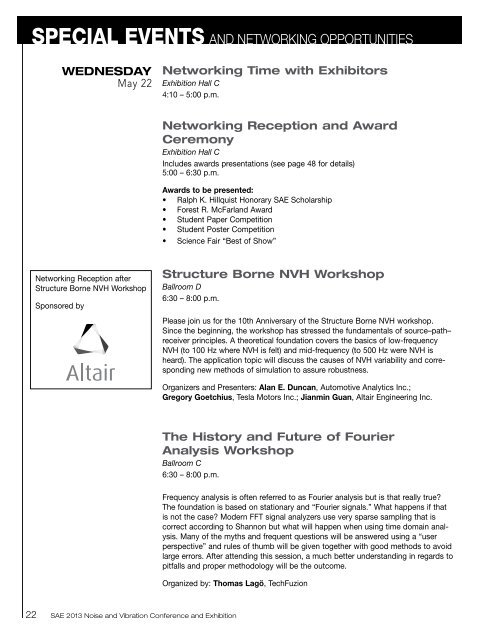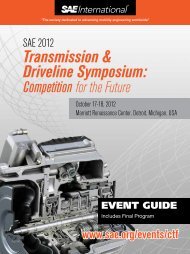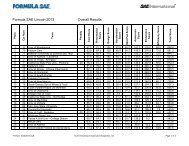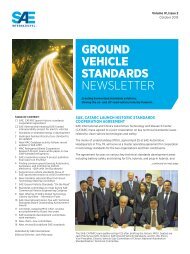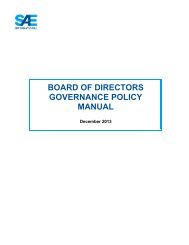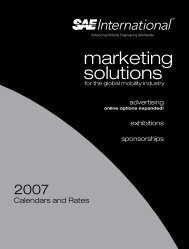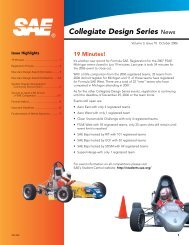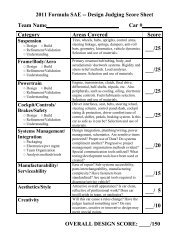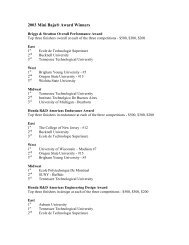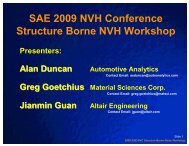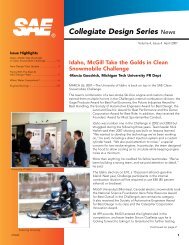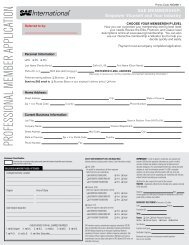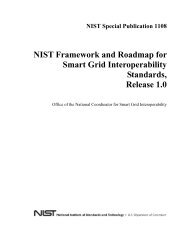Download Event Guide - SAE
Download Event Guide - SAE
Download Event Guide - SAE
You also want an ePaper? Increase the reach of your titles
YUMPU automatically turns print PDFs into web optimized ePapers that Google loves.
Special <strong>Event</strong>s and Networking Opportunities<br />
WEDNESDAY<br />
May 22<br />
Networking Time with Exhibitors<br />
Exhibition Hall C<br />
4:10 – 5:00 p.m.<br />
Networking Reception and Award<br />
Ceremony<br />
Exhibition Hall C<br />
Includes awards presentations (see page 48 for details)<br />
5:00 – 6:30 p.m.<br />
Awards to be presented:<br />
• Ralph K. Hillquist Honorary <strong>SAE</strong> Scholarship<br />
• Forest R. McFarland Award<br />
• Student Paper Competition<br />
• Student Poster Competition<br />
• Science Fair “Best of Show”<br />
Networking Reception after<br />
Structure Borne NVH Workshop<br />
Sponsored by<br />
Structure Borne NVH Workshop<br />
Ballroom D<br />
6:30 – 8:00 p.m.<br />
Please join us for the 10th Anniversary of the Structure Borne NVH workshop.<br />
Since the beginning, the workshop has stressed the fundamentals of source–path–<br />
receiver principles. A theoretical foundation covers the basics of low-frequency<br />
NVH (to 100 Hz where NVH is felt) and mid-frequency (to 500 Hz were NVH is<br />
heard). The application topic will discuss the causes of NVH variability and corresponding<br />
new methods of simulation to assure robustness.<br />
Organizers and Presenters: Alan E. Duncan, Automotive Analytics Inc.;<br />
Gregory Goetchius, Tesla Motors Inc.; Jianmin Guan, Altair Engineering Inc.<br />
The History and Future of Fourier<br />
Analysis Workshop<br />
Ballroom C<br />
6:30 – 8:00 p.m.<br />
Frequency analysis is often referred to as Fourier analysis but is that really true?<br />
The foundation is based on stationary and “Fourier signals.” What happens if that<br />
is not the case? Modern FFT signal analyzers use very sparse sampling that is<br />
correct according to Shannon but what will happen when using time domain analysis.<br />
Many of the myths and frequent questions will be answered using a “user<br />
perspective” and rules of thumb will be given together with good methods to avoid<br />
large errors. After attending this session, a much better understanding in regards to<br />
pitfalls and proper methodology will be the outcome.<br />
Organized by: Thomas Lagö, TechFuzion<br />
22<br />
<strong>SAE</strong> 2013 Noise and Vibration Conference and Exhibition


